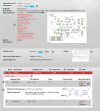DIANA-microT web server: elucidating microRNA functions through target prediction
- PMID: 19406924
- PMCID: PMC2703977
- DOI: 10.1093/nar/gkp292
DIANA-microT web server: elucidating microRNA functions through target prediction
Abstract
Computational microRNA (miRNA) target prediction is one of the key means for deciphering the role of miRNAs in development and disease. Here, we present the DIANA-microT web server as the user interface to the DIANA-microT 3.0 miRNA target prediction algorithm. The web server provides extensive information for predicted miRNA:target gene interactions with a user-friendly interface, providing extensive connectivity to online biological resources. Target gene and miRNA functions may be elucidated through automated bibliographic searches and functional information is accessible through Kyoto Encyclopedia of Genes and Genomes (KEGG) pathways. The web server offers links to nomenclature, sequence and protein databases, and users are facilitated by being able to search for targeted genes using different nomenclatures or functional features, such as the genes possible involvement in biological pathways. The target prediction algorithm supports parameters calculated individually for each miRNA:target gene interaction and provides a signal-to-noise ratio and a precision score that helps in the evaluation of the significance of the predicted results. Using a set of miRNA targets recently identified through the pSILAC method, the performance of several computational target prediction programs was assessed. DIANA-microT 3.0 achieved there with 66% the highest ratio of correctly predicted targets over all predicted targets. The DIANA-microT web server is freely available at www.microrna.gr/microT.
Figures

Similar articles
-
DIANA-microT web server v5.0: service integration into miRNA functional analysis workflows.Nucleic Acids Res. 2013 Jul;41(Web Server issue):W169-73. doi: 10.1093/nar/gkt393. Epub 2013 May 16. Nucleic Acids Res. 2013. PMID: 23680784 Free PMC article.
-
Accurate microRNA target prediction correlates with protein repression levels.BMC Bioinformatics. 2009 Sep 18;10:295. doi: 10.1186/1471-2105-10-295. BMC Bioinformatics. 2009. PMID: 19765283 Free PMC article.
-
DIANA-microT Web server upgrade supports Fly and Worm miRNA target prediction and bibliographic miRNA to disease association.Nucleic Acids Res. 2011 Jul;39(Web Server issue):W145-8. doi: 10.1093/nar/gkr294. Epub 2011 May 6. Nucleic Acids Res. 2011. PMID: 21551220 Free PMC article.
-
Practical Aspects of microRNA Target Prediction.Curr Mol Med. 2011 Mar;11(2):93-109. doi: 10.2174/156652411794859250. Curr Mol Med. 2011. PMID: 21342132 Free PMC article. Review.
-
Progress in miRNA target prediction and identification.Sci China C Life Sci. 2009 Dec;52(12):1123-30. doi: 10.1007/s11427-009-0159-4. Epub 2009 Dec 17. Sci China C Life Sci. 2009. PMID: 20016969 Review.
Cited by
-
Changes in hypothalamic expression of the Lin28/let-7 system and related microRNAs during postnatal maturation and after experimental manipulations of puberty.Endocrinology. 2013 Feb;154(2):942-55. doi: 10.1210/en.2012-2006. Epub 2013 Jan 4. Endocrinology. 2013. PMID: 23291449 Free PMC article.
-
The stretch responsive microRNA miR-148a-3p is a novel repressor of IKBKB, NF-κB signaling, and inflammatory gene expression in human aortic valve cells.FASEB J. 2015 May;29(5):1859-68. doi: 10.1096/fj.14-257808. Epub 2015 Jan 28. FASEB J. 2015. PMID: 25630970 Free PMC article.
-
Novel MicroRNAs regulating proliferation and apoptosis in uterine papillary serous carcinomas.Cancer Lett. 2013 Jul 28;335(2):314-22. doi: 10.1016/j.canlet.2013.02.043. Epub 2013 Feb 26. Cancer Lett. 2013. PMID: 23454583 Free PMC article.
-
Genome-wide identification of translationally inhibited and degraded miR-155 targets using RNA-interacting protein-IP.RNA Biol. 2013 Jun;10(6):1018-29. doi: 10.4161/rna.24553. Epub 2013 Apr 15. RNA Biol. 2013. PMID: 23673373 Free PMC article.
-
Accurate microRNA Target Prediction Using Detailed Binding Site Accessibility and Machine Learning on Proteomics Data.Front Genet. 2012 Jan 18;2:103. doi: 10.3389/fgene.2011.00103. eCollection 2011. Front Genet. 2012. PMID: 22303397 Free PMC article.
References
-
- Bartel DP. MicroRNAs: genomics, biogenesis, mechanism, and function. Cell. 2004;116:281–297. - PubMed
-
- Lee RC, Feinbaum RL, Ambros V. The C. elegans heterochronic gene lin-4 encodes small RNAs with antisense complementarity to lin-14. Cell. 1993;75:843–854. - PubMed
-
- Sethupathy P, Megraw M, Hatzigeorgiou AG. A guide through present computational approaches for the identification of mammalian microRNA targets. Nat. Methods. 2006;3:881–886. - PubMed
-
- Kertesz M, Iovino N, Unnerstall U, Gaul U, Segal E. The role of site accessibility in microRNA target recognition. Nat. Genet. 2007;39:1278–1284. - PubMed
-
- Long D, Lee R, Williams P, Chan CY, Ambros V, Ding Y. Potent effect of target structure on microRNA function. Nat. Struct. Mol. Biol. 2007;14:287–294. - PubMed
MeSH terms
Substances
LinkOut - more resources
Full Text Sources
Other Literature Sources

